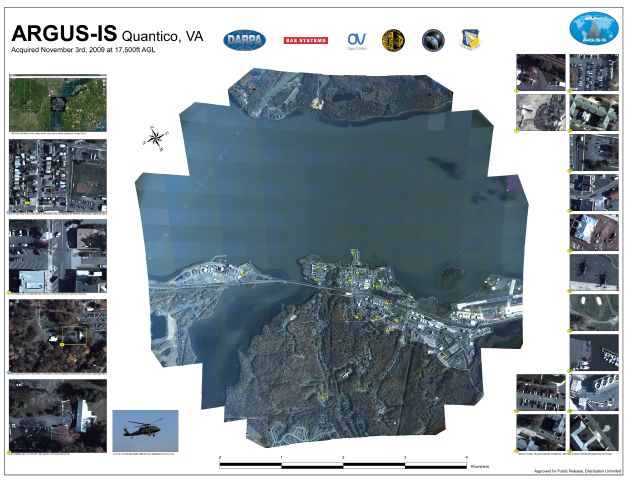Opmmur
Time Travel Professor
DARPAs 1.8 Gigapixel ARGUS-IS: Worlds Highest Resolution Surveillance System
Thursday, July 4, 2013 5:02
Nowhere to run, nowhere to hide. Once again, Big Brother has outdone himself. Here is just one more story about the surveillance technology available to government to spy on it’s enemies– oh, I mean you and me. Now they can see us making those “terrorist” phone calls, typing those “terrorist” emails, writing those “terrorist” snail mail letters and watch us drop them into the nearest mailbox. Crystal clear from 20,000 feet. Nice. And this is just one of the technologies they are telling us about. According the this article from LeakSource, they don’t even know what they are going to do with this technology. Uh Hmm. Take a look and see what you think they aregoing to do already doing with it. And where did the name “ARGUS” come from? Argus, from mythology, is the name of a giant with 100 eyes.

From: LeakSource
DARPA and the US Army have taken the wraps off ARGUS-IS, a 1.8-gigapixel video surveillance platform that can resolve details as small as six inches from an altitude of 20,000 feet (6km). ARGUS is by far the highest-resolution surveillance platform in the world, and probably the highest-resolution camera in the world, period.
ARGUS, which would be attached to some kind of unmanned UAV (such as the Predator) and flown at an altitude of around 20,000 feet, can observe an area of 25 square kilometers (10sqmi) at any one time. If ARGUS was hovering over New York City, it could observe half of Manhattan. Two ARGUS-equipped drones, and the US could keep an eye on the entirety of Manhattan, 24/7.
It is the definition of “observe” in this case that will blow your mind, though. With an imaging unit that totals 1.8 billion pixels, ARGUS captures video (12 fps) that is detailed enough to pick out birds flying through the sky, or a lost toddler wandering around. These 1.8 gigapixels are provided via 368 smaller sensors, which DARPA/BAE says are just 5-megapixel smartphone camera sensors. These 368 sensors are focused on the ground via four image-stabilized telescopic lenses. more here>>
Thursday, July 4, 2013 5:02
(Before It's News)Nowhere to run, nowhere to hide. Once again, Big Brother has outdone himself. Here is just one more story about the surveillance technology available to government to spy on it’s enemies– oh, I mean you and me. Now they can see us making those “terrorist” phone calls, typing those “terrorist” emails, writing those “terrorist” snail mail letters and watch us drop them into the nearest mailbox. Crystal clear from 20,000 feet. Nice. And this is just one of the technologies they are telling us about. According the this article from LeakSource, they don’t even know what they are going to do with this technology. Uh Hmm. Take a look and see what you think they are

From: LeakSource
DARPA and the US Army have taken the wraps off ARGUS-IS, a 1.8-gigapixel video surveillance platform that can resolve details as small as six inches from an altitude of 20,000 feet (6km). ARGUS is by far the highest-resolution surveillance platform in the world, and probably the highest-resolution camera in the world, period.
ARGUS, which would be attached to some kind of unmanned UAV (such as the Predator) and flown at an altitude of around 20,000 feet, can observe an area of 25 square kilometers (10sqmi) at any one time. If ARGUS was hovering over New York City, it could observe half of Manhattan. Two ARGUS-equipped drones, and the US could keep an eye on the entirety of Manhattan, 24/7.
It is the definition of “observe” in this case that will blow your mind, though. With an imaging unit that totals 1.8 billion pixels, ARGUS captures video (12 fps) that is detailed enough to pick out birds flying through the sky, or a lost toddler wandering around. These 1.8 gigapixels are provided via 368 smaller sensors, which DARPA/BAE says are just 5-megapixel smartphone camera sensors. These 368 sensors are focused on the ground via four image-stabilized telescopic lenses. more here>>
